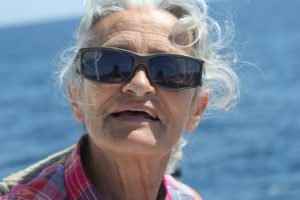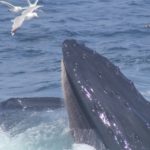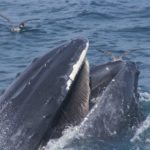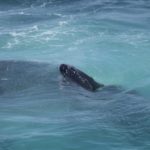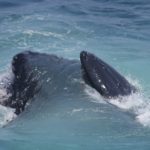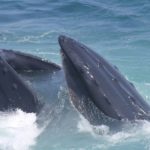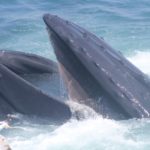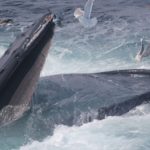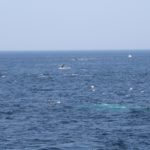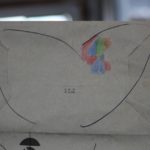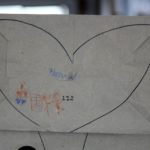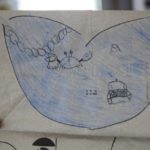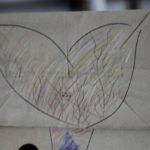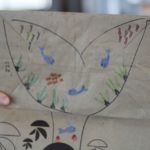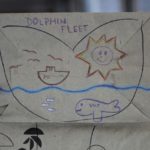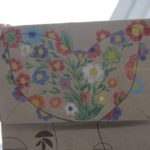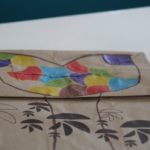Naturalist’s Notebook – July 30, 2016 to August 05, 2016
This week, I overheard some passengers asking if they could get tickets to go on the Dolphin VII. They were told by the ticket person that they didn’t want to go on “that boat” because it is such a “little boat.” The Dolphin VII is ten feet shorter than the other boats. That is true. So the other boats have twenty extra feet of rail space (ten feet on both sides). The ticket booth will fill that twenty feet with an extra one hundred twenty five passengers. If you are looking for your whalewatch to be a social event like speed dating where you meet lots of new people in a short period of time, then the “bigger” boats are for you. If, however, you are looking for a more comfortable experience on a boat with enough viewing space for its passengers, you should consider whalewatching on the Dolphin VII. Given the choice, I would always choose to go on the Dolphin VII. It is not as tall or as long as the other boats but, unless you are seven feet tall, it offers a far more comfortable experience with a crew of the same size as all of the larger boats. That means the naturalist has more time available per passenger to answer your questions and explain what you are seeing. It also means the galley crew has more time per passenger to tend to your food and beverage and comfort needs. It also means the two restrooms are far less likely to have a line when you need them. Without tables in the cabin, true, you have to hold your plates in your laps, but when the weather turns to rain or cold, the cabin holds nearly double the amount of passengers as the ones on the bigger boats. These are just a few things to keep in mind when you are deciding what departure time you wish to take and what boat you wish to whalewatch on.
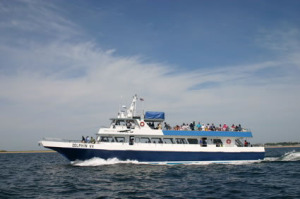
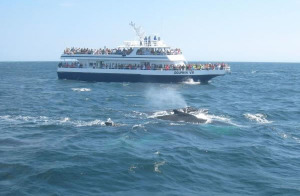
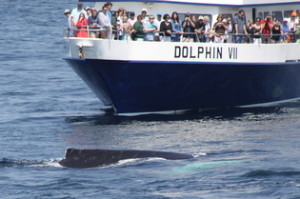
This week, there were a couple of things that almost started to become routine. First, almost every trip found one or more finback whales near Race Point. As the week progressed, the numbers of those finbacks rose. Down the beach toward Peaked Hill, a number of humpbacks could usually be found. And on the eastern slopes of Stellwagen, large numbers of humpbacks could be seen. Most of the whalewatch trips this week saw the finbacks near Race Point and then continued northeast to view the larger congregation of humpbacks. Depending on when your boat happened to be at the scene, there were a number of scenarios you might have watched play out.
1: Many of our trips this week found adult whales feeding beneath the surface, allowing their calves (and any adults that were “full”) time to exercise at the surface. They were seen on many trips running through the gambit of humpback whale behaviors like flipper-slapping, lobtailling, and breaching in its various forms.
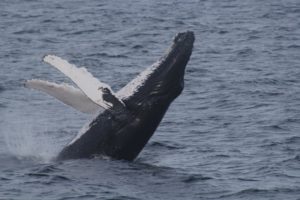
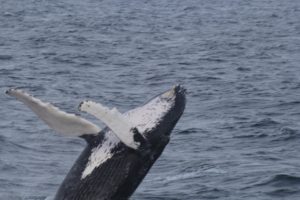
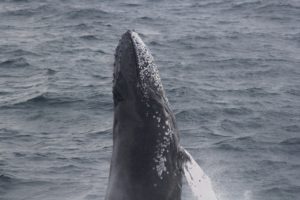
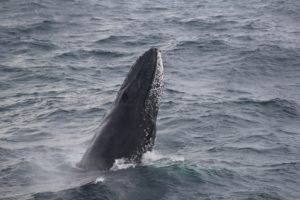
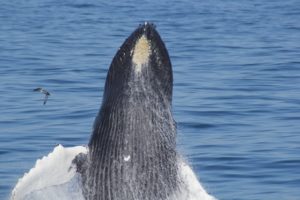
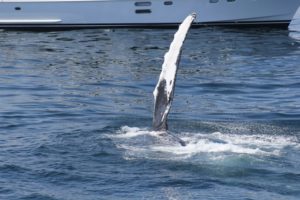
2: Many of our other trips arrived to a very different scene. From the distance, you could see the clouds of seabirds and the splashes of the whales as the used their huge tails to create areas of disturbance before lunging through the vast schools of fish below the surface and emerged from their bubble systems in numbers that this week ranged from one to twelve. Some of the time, you could see the small fish trying to get out of the way or even trying to escape from within the open mouths of the whales. And some others, you could see the gulls and shearwaters trying to steal a quick meal out of the forage fish that was being herded toward the surface. Occasionally, one would actually attempt to steal its meal from inside the opened mouth of the whale. They also were seen standing on the heads of dragging humpbacks and sliding down the rostrums to drop back into the water, reminding me of what my friends would look like going down the sliding board at the town pool.
3: And some of the trips were there when the big changes occurred. Either the change from everybody feeding on forage fish that was deep beneath the surface to everybody feeding on the schools at the surface. Or the other way around.
4: Other trips would be a bit more relaxing for the whales. All living beings need rest. Whales are no exception. Logging humpback whales afford a exciting opportunity to get a really good look at just how large and impressive these animals actually are. And resting animals are animals that are already not involved with finding food. This is the state where they are most likely to become curious about things in their environment. And, as for resting calves, have you ever tried to take a nap with a toddler? Many a wonderful interaction began this week with resting humpback whales and their calves.
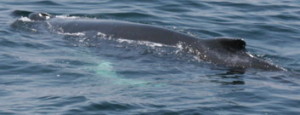
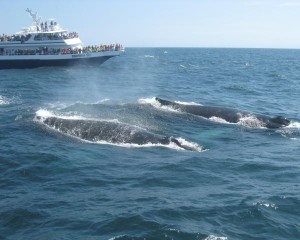
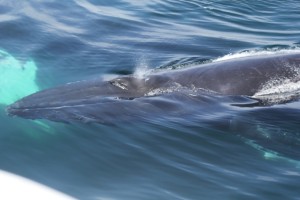
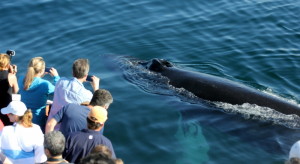
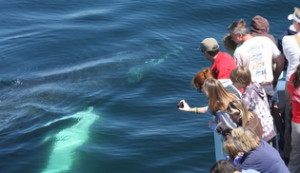
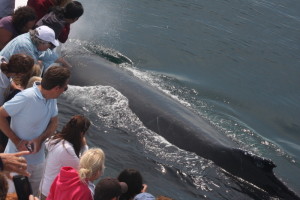
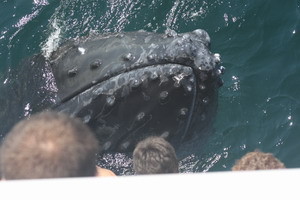
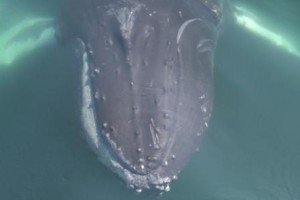
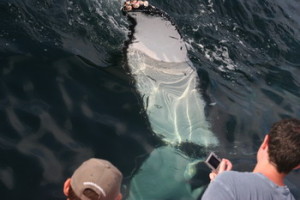
4: And for those of you that are purely numbers people, many of the trips reported numbers of humpback whales that exceeded 20 or 25. And there were a few that broke 35 or 40. One trip this week even reported numbers of 48 to 66. But the largest numbers of humpback whales were reported from the Dolphin VIII on August 2. According to Nancy Scaglione-Peck, the 9:00 voyage saw between 124 and 155 humpback whales during their adventure.
I caution those of you that rate how much you enjoyed your trip based on just numbers that I have seen many a trip in my career on which 25 humpbacks have spent 90 percent of the trip very close around us but also beneath the surface and only were visible for a couple of quick breaths every twelve minutes or so. One humpback whale, or even one minke whale, that swims around the boat for twenty minutes gives you a far better look.
And if you were whalewatching on the 9:00 trip on July 30, you would have been invited to participate in a brief experiment to demonstrate how and why humpback whales have names. Humpback whales are given names based on the natural marking on their bodies that are unique to them, for example, the pattern of coloration on the undersides of their flukes. Those names are designed to be memory aids so that when the whale is seen in the wild, it can be identified and information about that whale can be remembered or looked up.
For our experiment, a brief explanation was given and photos of numerous humpback flukes were made available. Passengers were invited to draw patterns on the way out to the whales that we would then hold a brief naming for on the way back into port. Here are the results.
Name them on your own.
I would also like to take just a moment to thank my dear friend and colleague Genevieve Martin for her help over the years in designing and executing the Saturday morning children’s program. Without her help I would never have been able to keep this program evolving so that there were newer, more up to date activities for the young and the young at heart. Thank you, my friend.
